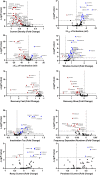Expanded clinical phenotype spectrum correlates with variant function in SCN2A-related disorders
- PMID: 38651838
- PMCID: PMC11292900
- DOI: 10.1093/brain/awae125
Expanded clinical phenotype spectrum correlates with variant function in SCN2A-related disorders
Erratum in
-
Correction to: Expanded clinical phenotype spectrum correlates with variant function in SCN2A-related disorders.Brain. 2025 Feb 3;148(2):e12. doi: 10.1093/brain/awae285. Brain. 2025. PMID: 39271170 Free PMC article. No abstract available.
Abstract
SCN2A-related disorders secondary to altered function in the voltage-gated sodium channel Nav1.2 are rare, with clinically heterogeneous expressions that include epilepsy, autism and multiple severe to profound impairments and other conditions. To advance understanding of the clinical phenotypes and their relationship to channel function, 81 patients (36 female, 44%, median age 5.4 years) with 69 unique SCN2A variants were systematically phenotyped and their Nav1.2 channel function systematically assessed. Participants were recruited through the FamileSCN2A Foundation. Primary phenotype (epilepsy of neonatal onset, n = 27; infant onset, n = 18; and later onset n = 24; and autism without seizures, n = 12) was strongly correlated with a non-seizure severity index (P = 0.002), which was based on presence of severe impairments in gross motor, fine motor, communication abilities, gastrostomy tube dependence and diagnosis of cortical visual impairment and scoliosis. Non-seizure severity was greatest in the neonatal-onset group and least in the autism group (P = 0.002). Children with the lowest severity indices were still severely impaired, as reflected by an average Vineland Adaptive Behavior composite score of 49.5 (>3 standard deviations below the norm-referenced mean of the test). Epileptic spasms were significantly more common in infant-onset (67%) than in neonatal (22%) or later-onset (29%) epilepsy (P = 0.007). Primary phenotype was also strongly correlated with variant function (P < 0.0001); gain-of-function and mixed function variants predominated in neonatal-onset epilepsy, shifting to moderate loss of function in infant-onset epilepsy and to severe and complete loss of function in later-onset epilepsy and autism groups. Exploratory cluster analysis identified five groups, representing: (i) primarily later-onset epilepsy with moderate loss-of-function variants and low severity indices; (ii) mostly infant-onset epilepsy with moderate loss-of-function variants but higher severity indices; and (iii) late-onset and autism only, with the lowest severity indices (mostly zero) and severe/complete loss-of-function variants. Two exclusively neonatal clusters were distinguished from each other largely on non-seizure severity scores and secondarily on variant function. The relationship between primary phenotype and variant function emphasizes the role of developmental factors in the differential clinical expression of SCN2A variants based on their effects on Nav1.2 channel function. The non-seizure severity of SCN2A disorders depends on a combination of the age at seizure onset (primary phenotype) and variant function. As precision therapies for SCN2A-related disorders advance towards clinical trials, knowledge of the relationship between variant function and clinical disease expression will be valuable for identifying appropriate patients for these trials and in selecting efficient clinical outcomes.
Keywords: Nav1.2; autism; automated patch clamp; developmental and epileptic encephalopathy; epilepsy.
© The Author(s) 2024. Published by Oxford University Press on behalf of the Guarantors of Brain.
Conflict of interest statement
A.T.B. reports consulting fees from Biogen, Biohaven Pharmaceuticals and Encoded Therapeutics, and honoraria from Biomarin Pharmaceuticals. S.E. reports consulting fees from Praxis Precision Medicine and Ovid Therapeutics. A.L.G. reports research funding from Biohaven, Praxis and Neurocrine. He is a member of the Scientific Advisory Board for Tevard.
Figures



References
-
- Heron SE, Crossland KM, Andermann E, et al. Sodium-channel defects in benign familial neonatal-infantile seizures. Lancet. 2002;360:851–852. - PubMed
-
- Herlenius E, Heron SE, Grinton BE, et al. SCN2A mutations and benign familial neonatal-infantile seizures: The phenotypic spectrum. Epilepsia. 2007;48:1138–1142. - PubMed
-
- Wolff M, Johannesen KM, Hedrich UBS, et al. Genetic and phenotypic heterogeneity suggest therapeutic implications in SCN2A-related disorders. Brain. 2017;140:1316–1336. - PubMed
MeSH terms
Substances
Grants and funding
LinkOut - more resources
Full Text Sources
Medical
Research Materials

